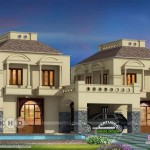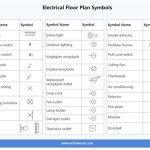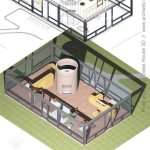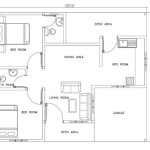Two-Bedroom House Plan With Elevation: Design and Functionality
Two-bedroom house plans represent a popular choice for individuals and small families seeking a blend of affordability, comfortable living space, and manageable maintenance. These plans are versatile and can be adapted to various architectural styles and site conditions. Understanding the different aspects of a two-bedroom house plan, along with its elevation, is crucial for making informed decisions when building or renovating a home. This article provides a detailed exploration of two-bedroom house plans, focusing on the key elements of design, functionality, and elevation considerations.
The appeal of a two-bedroom house plan lies in its efficient use of space. They are ideal for single individuals, young couples, empty nesters, or small families with one child. The smaller footprint translates into lower construction costs, reduced property taxes, and lower utility bills. Furthermore, the manageable size makes cleaning and maintenance easier, freeing up time for other activities. The key is to maximize the usability of each room and create a layout that flows smoothly and feels spacious, despite the limited square footage.
Optimizing the Layout of a Two-Bedroom House Plan
Designing an effective two-bedroom house plan necessitates careful consideration of the layout. The arrangement of rooms should prioritize functionality and create a comfortable living environment. Common areas, such as the living room, dining area, and kitchen, should be centrally located and interconnected to facilitate social interaction. Bedrooms should be positioned away from these areas to provide privacy and a quiet retreat. The placement of bathrooms, laundry rooms, and storage spaces should be strategic to ensure convenience and accessibility.
A common design strategy is to incorporate an open-concept living area that combines the living room, dining area, and kitchen into a single, unified space. This layout creates a sense of spaciousness and allows for better natural light distribution. Kitchen islands or peninsulas can serve as functional dividers between the kitchen and the living area, providing additional counter space and seating. The bedrooms are typically located on either side of the living area or at the rear of the house to maximize privacy. Master bedrooms often include an en-suite bathroom and a walk-in closet, while the second bedroom can serve as a guest room, home office, or children's bedroom.
Another important aspect of layout optimization is circulation. Corridors should be wide enough to allow for comfortable movement, and the flow between rooms should be intuitive and unobstructed. Avoiding long, narrow hallways can prevent a cramped feeling. Consider incorporating strategically placed windows and doors to maximize natural light and ventilation throughout the house. A well-designed layout will seamlessly integrate indoor and outdoor living spaces, connecting the interior with patios, decks, or gardens.
The size of each room should be carefully considered based on its intended use. The living room should be large enough to accommodate comfortable seating and entertainment, while the bedrooms should be spacious enough to fit a bed, dresser, and other essential furniture. The kitchen should have ample counter space and storage to facilitate meal preparation. Bathrooms should be designed with functionality and accessibility in mind. Prioritizing storage space is crucial in smaller homes. Built-in shelves, closets, and overhead cabinets can help maximize storage without encroaching on living space.
Understanding House Elevation and its Impact
The house elevation is a two-dimensional drawing that shows the exterior appearance of the house from a specific viewpoint. Typically, elevations are drawn from the front, rear, and sides of the house. These drawings illustrate the architectural style, window and door placement, roof design, and exterior materials. The house elevation plays a crucial role in defining the overall aesthetic and curb appeal of the house.
Understanding the house elevation is essential for several reasons. It allows one to visualize the final appearance of the house before construction begins. It also helps in identifying potential design flaws or aesthetic issues. The house elevation provides important information for contractors and builders, ensuring that the construction accurately reflects the intended design. Furthermore, the house elevation is a key element in obtaining building permits and adhering to local zoning regulations.
The design of the house elevation should complement the architectural style of the house. Common architectural styles for two-bedroom houses include ranch, cottage, modern, and traditional. Ranch-style houses typically feature a low-pitched roof, horizontal lines, and a single-story layout. Cottage-style houses are characterized by steep roofs, dormers, and decorative details. Modern houses often incorporate clean lines, large windows, and minimalist design. Traditional houses tend to feature symmetrical facades, gabled roofs, and classic architectural elements.
The choice of exterior materials significantly impacts the appearance of the house elevation. Common materials include brick, siding, stucco, stone, and wood. Each material has its own unique aesthetic and performance characteristics. Brick is durable and provides a classic look, while siding is a more affordable and versatile option. Stucco offers a smooth, textured finish, while stone adds a rustic and natural touch. Wood can be used for siding, trim, and decorative elements, adding warmth and character to the house.
Window and door placement is another important aspect of house elevation design. Windows should be strategically placed to maximize natural light and ventilation while maintaining privacy. The size and style of windows should complement the architectural style of the house. Doors should be located to provide easy access to the house and integrate seamlessly with the overall design. Consider the use of decorative elements, such as shutters, trim, and landscaping, to enhance the curb appeal of the house.
Key Considerations for Energy Efficiency and Sustainability
Energy efficiency and sustainability are increasingly important considerations in modern house design. Designing a two-bedroom house plan with energy efficiency in mind can significantly reduce utility bills and minimize environmental impact. Several strategies can be employed to improve energy efficiency, including proper insulation, energy-efficient windows and doors, efficient HVAC systems, and solar panels.
Proper insulation is crucial for maintaining a comfortable indoor temperature and reducing energy consumption. Insulating walls, ceilings, and floors can prevent heat loss in the winter and heat gain in the summer. The type and thickness of insulation should be chosen based on the climate and building codes. Energy-efficient windows and doors can also significantly reduce energy loss. Look for windows and doors with low U-factors and high solar heat gain coefficients (SHGC) to minimize heat transfer.
Efficient HVAC systems can further reduce energy consumption. Consider installing a high-efficiency furnace, air conditioner, or heat pump. Programmable thermostats can help regulate the temperature based on occupancy and time of day. Solar panels can provide a renewable source of energy, reducing reliance on fossil fuels. Solar panels can be installed on the roof or ground-mounted, depending on site conditions and energy needs.
Sustainable design practices can also be incorporated into the house plan. Using recycled or renewable building materials, such as bamboo flooring, reclaimed wood, or recycled-content insulation, can reduce the environmental impact of construction. Designing the house to maximize natural light and ventilation can reduce the need for artificial lighting and air conditioning. Incorporating water-saving fixtures, such as low-flow toilets and showerheads, can conserve water. Landscaping with native plants can reduce the need for irrigation and create a more sustainable landscape.
Orienting the house to take advantage of solar gain can also improve energy efficiency. In colder climates, orienting the house to face south can maximize solar gain in the winter. In warmer climates, orienting the house to minimize solar gain can reduce the need for air conditioning. Overhangs and awnings can provide shade to windows and doors, reducing heat gain in the summer. Planting trees and shrubs around the house can also provide shade and reduce the urban heat island effect.
By carefully considering the layout, elevation, and energy efficiency of a two-bedroom house plan, one can create a comfortable, functional, and sustainable living space. The key is to prioritize functionality, maximize space utilization, and incorporate energy-efficient design principles.

Six Low Budget Kerala Model Two Bedroom House Plans Under 500 Sq Ft Small Hub

Four Low Budget Small House Plans From 500 Sq Ft To 650 Free Plan Elevation Hub

Two Bedroom House All Sided Elevations And Sectional Details Dwg File Cadbull

Architecture House Plan And Elevation Complete Drawing

Two Bedroom Bungalow All Sided Elevation Floor Plan Roof And Auto Cad Details Dwg File

2 Bedroom House Plans Plan Design Make My

Two Bedroom Small House Plan Cool Concepts

Small Ranch House Plan Two Bedroom Front Porch 109 1010

2 Bedroom House Plan North Facing N Style Bhk Elevation Design

Floor Plan And Elevations For The New House Wildfire Interiors








